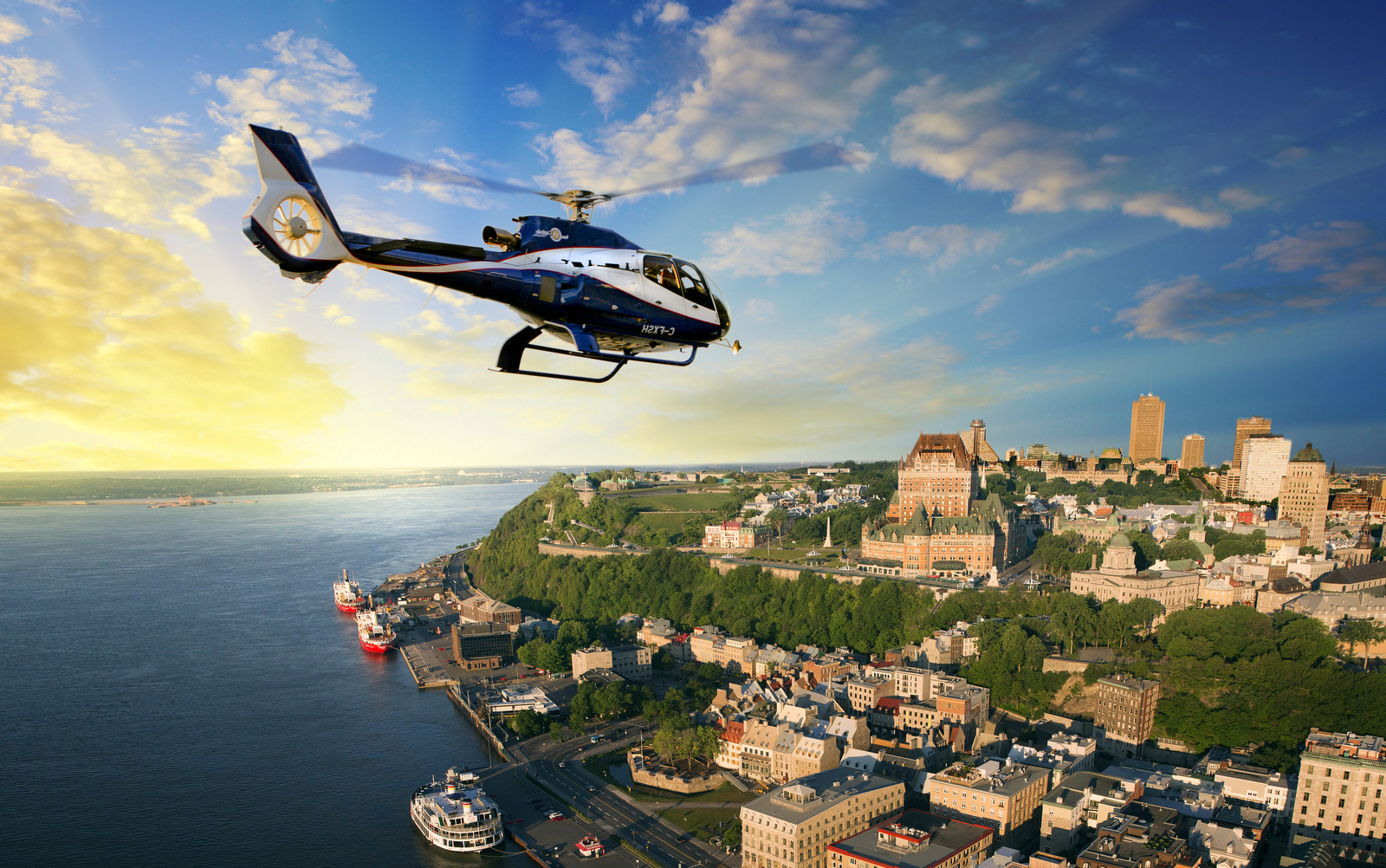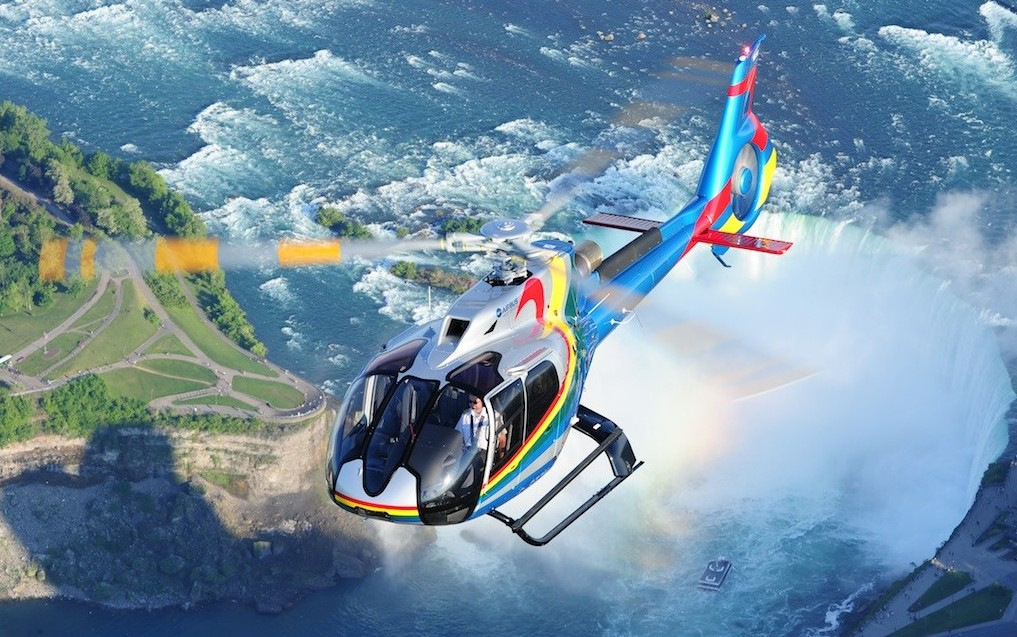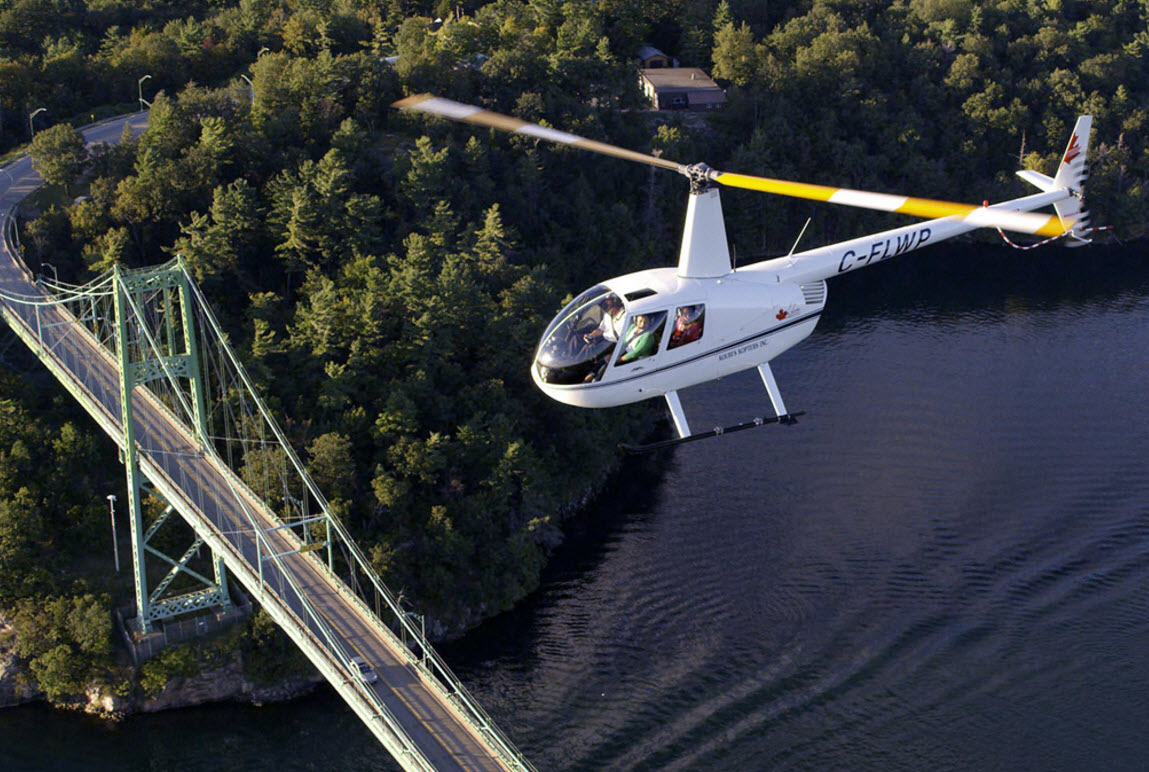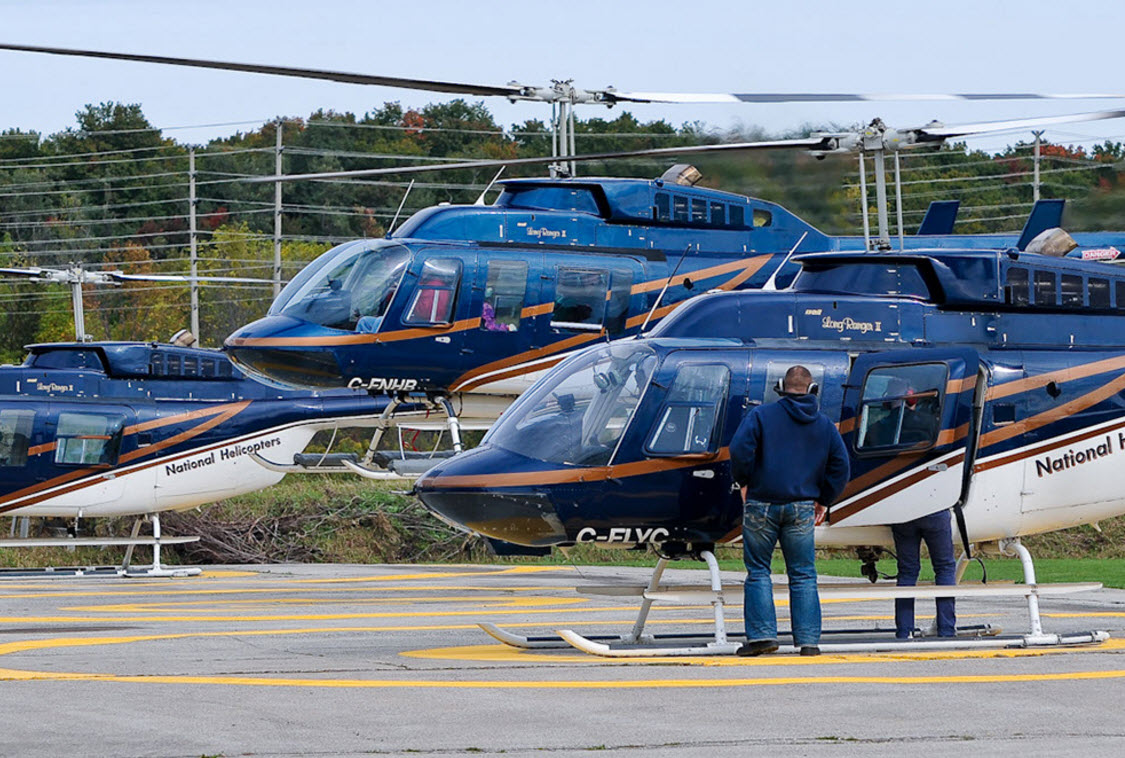Written for Vertical Magazine – August/September 2015
In the midst of the many challenges facing the industry, some of Canada’s helicopters operators are finding a bright spot. Fueled by tourists looking for a new perspective of the Great White North’s fabulous landscapes and skylines, the heli-sightseeing and heli-tourism sector is seeing growth. And with the Canadian dollar’s continued weakness against the U.S. dollar, the tourism industry north of the border is set to receive a serious boost from those looking to take advantage of the generous conversion rate. Vertical spoke with a number of Canadian operators to find out how they are serving vacationers.
Québec City, Que.-based GoHelico began heli-sightseeing flights in May 2013. Utilizing the fleet of sister-company Capitale Hélicoptère, three machines are assigned to sightseeing flights — an Airbus Helicopters H130 and H120, and a Robinson R44. Although GoHelico has only been operating for a little over two years, the company is doing very well, according to marketing director Anne Douville. “We carried 2,500 passengers in 2014, and we estimate 8,000 passengers in 2015, and 16,000 in 2016,” she told Vertical.
Operating year-round, GoHelico flies two to 12 departures per day. Most passengers are local Québec residents, with the remainder generally coming from either Mexico, Germany, Belgium, France, the U.S., or elsewhere in Canada. About 10 percent of GoHelico’s passengers arrive from cruise ships or as part of inclusive tours, and Douville uses various travel distribution channels to promote flights. “We buy advertising in many tourist publications, we have a strong presence on the web, and we produce videos we hope go viral,” she said. The most popular tour is the 30-minute “Québec, its river, its landscapes” flight at a cost of C$180 per passenger.
Over in Ontario, Niagara Helicopters has been completing regular flights for awestruck passengers over Niagara Falls for more than 30 years, making it the oldest aerial tourism operator in Canada. Last year, the company flew over 100,000 passengers from its base just north of Niagara Falls, Ont., according to Anna Pierce, vice president and general manager. “Our average is 85 rides a day in the summer, with four aircraft,” she said. “The pilots fly between 18 and 24 flights — depending on who’s going to be the ‘air hog’ for the day!”
Earlier this year, Niagara transitioned from the Bell 407 to a fleet of four new Airbus Helicopters H130s. (The 407s are to be transitioned into parent company Helicopter Transport Services’ fleet, where they will be used for bush flying.) “The Bells were amazing and they did wonderful work for us,” said Pierce, “but the 130s have a lot more creature comforts. Our pilots and passengers really, really, appreciate the air conditioning. With the panoramic view and all forward facing seats, there’s so much about this machine that’s so well suited to the tourism industry.”
September is Niagara’s biggest month for international bus groups, which makes up 55 percent of its business. With as many as 11 or 12 buses in the parking lot and hundreds of passengers waiting to fly, the key to Niagara’s smooth operation is “keeping the timing immaculate,” says Pierce. “You have to know how to book them, and ‘turn them.’ ” Passenger movements and helicopter refueling are done “hot” with engines running and rotors turning. Pierce says that Niagara’s skilled ground crew can do a turn, with seven passengers in the high-skid-equipped H130, in a super-quick one minute and 47 seconds.
In addition to Niagara’s “bread-and-butter” nine-minute loop over the Falls, the company flies charters to the region’s wineries, and also has heli-weddings on its list of services. Pierce says that attending international travel conferences is a key promotional effort for Niagara. “We’re very lucky because so many people come to Canada to see the Falls,” she said. The company also has the built-in advertising of its helicopters flying over the Falls dozens of times a day, in front of thousands of visitors.
Kleinburg, Ont.-based National Helicopters also flies in the CYR 518 airspace over the falls, from a base at Niagara District Airport, just north of St. Catharines, Ont. The company dedicates three Bell 206B or 206L machines to heli-sightseeing both in the Niagara region, and over downtown Toronto. According to Andrew Dunt, vice president of operations, marketing and sales, the pilots and passengers all like the Bells, and “they provide great cost effectiveness for the job.” The company is looking forward to a 20 percent increase in passengers flown this year, up to 10,000 from 8,000 in 2014. Dunt says that National flies year-round, with up to 20 flights per day in the busy summer months. A large number of passengers arrive on bus tours from all over the world, and Dunt primarily uses the internet to promote the company’s services.
A Varied Offering
Further east, on the north shore of Lake Ontario, Kouri’s Kopters operates three, three-passenger Robinson R44s from its base in Gananoque, Ont. “We love this machine,” said Ewelina Sobala, sales and marketing for Kouri’s. “Operating costs are low, and our customers get an intimate experience, being able to converse with the pilot, and everyone gets a window seat.” Kouri’s has been operating sightseeing flights over the Thousand Islands, an archipelago that straddles the Canada-U.S. border where the Saint Lawrence River meets Lake Ontario, since 2008. Its most popular flight is the “Boldt Castle Tour,” a C$149-per-passenger, 20-minute tour over the iconic castle located on Heart Island. In addition to its Thousand Islands tours, Kouri’s has a unique winter excursion, said Sobala. “We offer ice fishing by helicopter. It’s fully guided, includes all gear and food, with day and overnight packages available.”
Sobala said Kouri’s flies “a lot of local customers,” along with visitors from Europe, China, India and the rest of Canada. Two thousand passengers enjoyed flights in 2014, and Kouri’s hopes to double that number in 2015. A mixed marketing effort is key to the company’s success, according to Sobala. “Online marketing is very helpful, as you can track your buys,” she said. “We still use print for local marketing. Social media is huge, but you have to be regularly active on all of your accounts. We’ve also recently started to market internationally with travel trade shows.”
Out on Canada’s West Coast, Khalil Nazerali joined Blackcomb Aviation as marketing co-ordinator in 2014. “In the late 1990s, tourism was a huge part of our business,” said Nazerali. “Our big push is to get back to those levels. We’re dedicating aircraft and pilots, we’re coming up with marketing strategies and budget, and have hired staff specifically for tourism.” The company’s efforts are getting results, with more than a 20 percent growth over the past two years, according to Nazerali.
Blackcomb keeps an Airbus Helicopters H130 based on the top of Whistler Mountain, a Bell 206 on the top of Vancouver’s north-shore Grouse Mountain, and a third machine at its base just north of Whistler Village. Nazerali is enthusiastic about the H130, which joined the fleet in January 2015. “It changes the whole tour quality,” he said. “It has massive windows, stadium seating, and the Fenestron. It’s ideal for tourism.”
In addition to tourists from the U.S., Canada, Europe and Asia, the Australian market is important to Blackcomb, with Scenic Tours and Australian Pacific Touring bringing visitors to Whistler. “Our most popular flight is the ‘B.C. Experience,’ ” said Nazerali. The 24-minute flight explores the region, along with a 15-minute stop on Rainbow Glacier. “You shut down, have a snowball fight or make snow angels,” he said. “In the middle of July you’re standing on a foot of snow. That’s a big selling point for our Aussie guests.”
Nazerali said that building and maintaining relationships with hotels in the area, tour resellers and destination management companies is key to the company’s success, and he said Blackcomb is in the process of rebranding its website. “We’re going to have a tourism-based website, and then a utility-based website,” he said. “If you have a consumer, they don’t really care if you’ve moved power lines; they want to see the tour, and they want to see photos. They want to see it from a fun, exciting side.”
Blackcomb also provides machines for heli-skiing, and has a slate of heli-adventures, which include glacier and alpine walks, and fully-catered alpine picnics. The company recently arranged a 5-star corporate retreat dinner at isolated Beverly Lake for 55 people, flying in all of the guests, staff and supplies. “We actually flew up a set of porta-potties,” said Nazerali. “That was a sight to see, on a helicopter long-line, flying to the top of the mountain!”
Maximizing Revenue
Heli-sightseeing operators are generating ancillary revenue through the before-and-after-flight sales of company-branded promotional items. At GoHelico and Niagara Helicopters, passengers can purchase a photo of their experience. Niagara also takes advantage of its large number of visitors by funneling them through a fully-stocked gift shop. “If we compare it to other gift shops [in the area], it does very well,” said Niagara’s Pierce. She added that the company has been looking at the idea of selling DVDs of each flight, “but the turnaround is so quick, we haven’t quite figured it out yet.”
All of the operators agreed that their pilots’ personalities are an important factor in providing a once-in-a-lifetime experience to passengers. “We look for pilots who are really friendly, and who like to talk to people,” said Pierce. “Our passengers are excited, and they see that friendly attitude and it bolsters them up.”
GoHelico’s pilots are former students of sister-company Capitale Hélicoptère, and must have great interpersonal skills, and be bilingual, according to Douville. “Our pilots are also very passionate, diligent, careful and friendly, and they want to provide the best customer service in the industry,” she said.
National Helicopters generally hires pilots who have graduated from the company’s flight school, “so we know their qualities,” said Dunt. He admits, though, that the pilots flying the same sightseeing flight day-after-day can become bored with the routine. “I know I did, when I circled the CN Tower [in Toronto] 3,000 times in two years! But for balance, our Toronto tour pilots also do charter work and get to fly our Niagara Falls tours, which is one of the best views in the world.” he said.
Niagara’s Pierce agreed: “Of course, every once in a while a pilot will say, ‘I’m starting to get a little punch drunk out here, can I switch off for a bit?’ ” Niagara has 10 pilots: five full-time, and five part-time. “Our full-time guys are here five days a week, and they get to go home and sleep in their own beds every night,” explained Pierce. “Then we have a group of pilots who come in when they have down time from their other contracts. We have one pilot who’s been flying with us part-time for 28 years. They don’t leave — which is a good thing!”
The operators are all looking forward to continued growth in this sector. “Heli-tourism is an interesting way to stimulate tourism in our city in a whole new way,” said GoHelico’s Douville. National’s Dunt said that he’s seen a slight uptrend in tourism from past years, “but there’s still a ways to go! There’s also a trend in the requirement for twin-engine helicopters, mostly to higher-end VIP clients.”
“The main focus of heli-tourism is to celebrate the area where we live,” said Blackcomb’s Nazerali. “You take helitours in three different spots — one in the Grand Canyon, one in Hawaii, and one in Canada. That’s what I love about helicopter tourism; you get to see things that you normally wouldn’t!”



